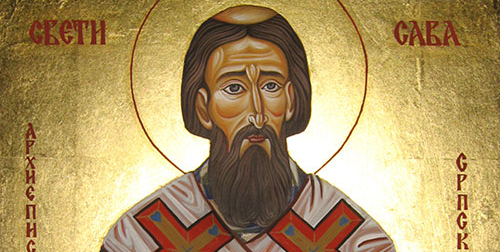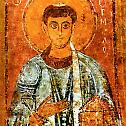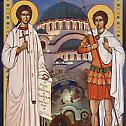Culture
From the Prologue
11. February 2018 - 0:58 JANUARY 29/FEBRUARY 11,
JANUARY 29/FEBRUARY 11,
BY SAINT NIKOLAI VELIMIROVIC:
The Holy Hieromartyr Ignatius the God-bearer
The principal feast of St. Ignatius is celebrated in winter, on December 20. On this date we commemorate the translation of his relics from Rome, where he suffered martyrdom, to Antioch, where he had earlier been bishop. When St. Ignatius was summoned to Rome to account for his faith before Emperor Trajan, he was accompanied on this long journey by several citizens from Antioch, who were motivated in this by a great love toward their wonderful archpastor. Since he would never deny his faith in Christ, this saint of God, who abhorred all the adulation and promises of Emperor Trajan, was condemned to death and thrown to wild beasts in the Circus Maximus. The wild beasts tore him apart, and he surrendered his soul to God. His companions then gathered his exposed bones, took them to Antioch, and honorably buried them. When the Persians captured Antioch in the sixth century, the relics of St. Ignatius were again translated from Antioch to Rome.
Apostle Timothy of the Seventy
4. February 2018 - 15:54 The Holy Apostle Timothy was from the Lycaonian city of Lystra in Asia Minor. Saint Timothy was converted to Christ in the year 52 by the holy Apostle Paul (June 29). When the Apostles Paul and Barnabas first visited the cities of Lycaonia, Saint Paul healed one crippled from birth. Many of the inhabitants of Lystra then believed in Christ, and among them was the future Saint Timothy, his mother Eunice and grandmother Loida (Lois) (Acts 14:6-12; 2 Tim. 1:5).
The Holy Apostle Timothy was from the Lycaonian city of Lystra in Asia Minor. Saint Timothy was converted to Christ in the year 52 by the holy Apostle Paul (June 29). When the Apostles Paul and Barnabas first visited the cities of Lycaonia, Saint Paul healed one crippled from birth. Many of the inhabitants of Lystra then believed in Christ, and among them was the future Saint Timothy, his mother Eunice and grandmother Loida (Lois) (Acts 14:6-12; 2 Tim. 1:5).
The seed of faith, planted in Saint Timothy’s soul by the Apostle Paul, brought forth abundant fruit. He became Saint Paul’s disciple, and later his constant companion and co-worker in the preaching of the Gospel. The Apostle Paul loved Saint Timothy and in his Epistles called him his beloved son, remembering his devotion and fidelity with gratitude.
Venerable and God-bearing Father Anthony the Great
30. January 2018 - 16:51 Saint Anthony the Great is known as the Father of monasticism, and the long ascetical sermon in The Life of Saint Anthony by Saint Athanasius (Sections 16-34), could be called the first monastic Rule.
Saint Anthony the Great is known as the Father of monasticism, and the long ascetical sermon in The Life of Saint Anthony by Saint Athanasius (Sections 16-34), could be called the first monastic Rule.
He was born in Egypt in the village of Coma, near the desert of the Thebaid, in the year 251. His parents were pious Christians of illustrious lineage. Anthony was a serious child and was respectful and obedient to his parents. He loved to attend church services, and he listened to the Holy Scripture so attentively, that he remembered what he heard all his life.
When Saint Anthony was about twenty years old, he lost his parents, but he was responsible for the care of his younger sister. Going to church about six months later, the youth reflected on how the faithful,in the Acts of the Apostles (4:35), sold their possessions and gave the proceeds to the Apostles for the needy.
Veneration of the Precious Chains of the Holy and All-Glorious Apostle Peter
29. January 2018 - 10:02 The Veneration of the Honorable Chains of the Holy and All-Praised Apostle Peter: In about the year 42, on the orders of Herod Agrippa, the Apostle Peter was thrown into prison for preaching about Christ the Savior. In prison he was held secure by two iron chains. During the night before his trial, an angel of the Lord removed these chains from the Apostle Peter and led him out from the prison (Acts 12:1-11).
The Veneration of the Honorable Chains of the Holy and All-Praised Apostle Peter: In about the year 42, on the orders of Herod Agrippa, the Apostle Peter was thrown into prison for preaching about Christ the Savior. In prison he was held secure by two iron chains. During the night before his trial, an angel of the Lord removed these chains from the Apostle Peter and led him out from the prison (Acts 12:1-11).
Christians who learned of the miracle took the chains and kept them as precious keepsakes. For three centuries the chains were kept in Jerusalem, and those who were afflicted with illness and approached them with faith received healing. Patriarch Juvenal (July 2) presented the chains to Eudokia, wife of the emperor Theodosius the Younger, and she in turn transferred them from Jerusalem to Constantinople in either the year 437 or 439.
Saint Sava I, First Archbishop of Serbia
26. January 2018 - 16:22 Saint Sava, First Archbishop of Serbia, in the world Rostislav (Rastko), was a son of the Serbian king Stephen Nemanya and Anna, daughter of the Byzantine Emperor Romanus. From his early years he fervently attended church services and had a special love for icons.
Saint Sava, First Archbishop of Serbia, in the world Rostislav (Rastko), was a son of the Serbian king Stephen Nemanya and Anna, daughter of the Byzantine Emperor Romanus. From his early years he fervently attended church services and had a special love for icons.
At seventeen years of age, Rostislav met a monk from Mount Athos, secretly left his father’s house and set off for the Saint Panteleimon monastery. (By divine Providence in 1169, the year of the saint’s birth, the ancient monastery of the Great Martyr and healer Panteleimon was given to Russian monks.)
St. Martyrs Ermil (Ermilus) and Stratonicus
26. January 2018 - 10:16The Martyr Saints Ermil and Stratonicus, in Greek ῞Ερμυλος and Στρατόνικος, or in Serbian Свети мученици, Eрмил и Cтратонjк бэлгрaдски (Sts. Martyrs Ermil and Stratonic of Belgrade) lived in 3rd – 4th centuries in the Roman province Illyricum, located on the middle course of the Danube, and received their martyrdom at Singidunum (the today Belgrade), being celebrated on January 13, their day of passage to the Lord.





